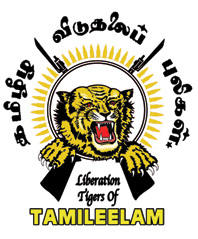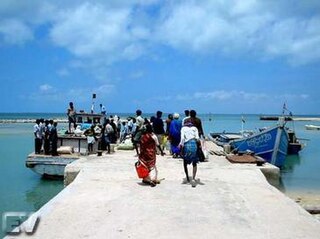
The Liberation Tigers of Tamil Eelam was a Tamil militant organization that was based in the northern and eastern Sri Lanka. The LTTE fought to create an independent Tamil state called Tamil Eelam in the northeast of the island in response to violent persecution and discriminatory policies against Sri Lankan Tamils by the Sinhalese-dominated Sri Lankan Government.

The Sri Lankan Civil War was a civil war fought in Sri Lanka from 1983 to 2009. Beginning on 23 July 1983, it was an intermittent insurgency against the government by the Liberation Tigers of Tamil Eelam led by Velupillai Prabhakaran. The LTTE fought to create an independent Tamil state called Tamil Eelam in the north-east of the island, due to the continuous discrimination and violent persecution against Sri Lankan Tamils by the Sinhalese-dominated Sri Lanka government.

Indian Peace Keeping Force (IPKF) was the Indian military contingent performing a peacekeeping operation in Sri Lanka between 1987 and 1990. It was formed under the mandate of the 1987 Indo-Sri Lankan Accord that aimed to end the Sri Lankan Civil War between Sri Lankan Tamil militant groups such as the Liberation Tigers of Tamil Eelam (LTTE) and the Sri Lankan military.
Sri Lankan state-sponsored colonization schemes is the government program of settling mostly Sinhalese farmers from the densely populated wet zone into the sparsely populated areas of the dry zone. This has taken place since the 1950s near tanks and reservoirs being built in major irrigation and hydro-power programs such as the Mahaweli project.

The 1977 anti-Tamil pogrom in Sri Lanka followed the 1977 general elections in Sri Lanka where the Sri Lankan Tamil nationalistic Tamil United Liberation Front won a plurality of minority Sri Lankan Tamil votes. In the elections, the party stood for secession. An official government estimate put the death toll at 125, whereas other sources estimate that around 300 Tamils were killed by Sinhalese mobs. Human rights groups, such as the UTHR-J, accused the newly elected UNP-led government of orchestrating the violence.

The Kumudini or Kumuthini boat massacre happened on 15 May 1985 when at least 23 minority Sri Lankan Tamil men, women and children on a ferry boat named Kumudini sailing from the island of Delft to the island of Nainathivu were killed by Sri Lankan Navy personnel.
The Kent and Dollar Farm massacres were the first massacres of Sinhalese civilians carried out by the LTTE during the Sri Lankan Civil War. The massacres took place on 30 November 1984, in two tiny farming villages in the Mullaitivu district in north-eastern Sri Lanka. The Sri Lankan government labeled this as an attack on civilians by the LTTE.
The Kalmunai massacre refers to a series of mass killings that occurred in June 1990 in Kalmunai, a municipality within the Ampara District of Sri Lanka's Eastern Province. The massacre of Tamil civilians was allegedly carried out by the Sri Lankan Army in retaliation for an earlier massacre of Sri Lankan police officers. The University Teachers for Human Rights, a human rights organization, put the number of dead in the second massacre at 250, while a local Member of Parliament claimed that at least 160 people were killed.
Operation Pawan was the code name assigned to the operation by the Indian Peace Keeping Force (IPKF) to take control of Jaffna from the Liberation Tigers of Tamil Eelam (LTTE), better known as the Tamil Tigers, in late 1987 to enforce the disarmament of the LTTE as a part of the Indo-Sri Lanka Accord. In brutal fighting lasting about three weeks, the IPKF took control of the Jaffna Peninsula from the LTTE, something that the Sri Lankan Army had tried but failed to do. Supported by Indian Army tanks, helicopter gunships and heavy artillery, the IPKF routed the LTTE at the cost of 214 soldiers and officers. Many Indian soldiers died
Eelam War I is the name given to the initial phase of the armed conflict between the government of Sri Lanka and the LTTE.

Eelam War II is the name given to the second phase of armed conflict between Sri Lankan military and the separatist Liberation Tigers of Tamil Eelam. The war started after the failure of peace talks between the Premadasa government and the LTTE. This phase of the war was initiated by the LTTE who massacred almost 600 Sinhalese and Muslim police personnel after they were ordered by the Premadasa government to surrender to the LTTE. The truce was broken on June 10, 1990 when the LTTE in October expelled all the 28,000 Muslims residing in Jaffna.
The Kattankudy Mosque Massacre was the killing of over 147 Muslim men and boys on 3 August, 1990. Around 30 armed Tamil militants raided two mosques in Kattankudy where over 300 people were prostrating in Isha prayers. The Sri Lankan government, survivors, and observers accuse the Liberation Tigers of Tamil Eelam (LTTE) of committing the crime. The LTTE denied involvement and never retracted the denial.

The Jaffna hospital massacre occurred on October 21 and 22, 1987, during the Sri Lankan Civil War, when troops of the Indian Peace Keeping Force entered the premises of the Jaffna Teaching Hospital in Jaffna, Sri Lanka, an island nation in South Asia, and killed between 60 and 70 patients and staff. The rebel Liberation Tigers of Tamil Eelam, the government of Sri Lanka, and independent observers such as the University Teachers for Human Rights and others have called it a massacre of civilians.
The Indian intervention in the Sri Lankan Civil War was the deployment of the Indian Peace Keeping Force in Sri Lanka intended to perform a peacekeeping role. The deployment followed the Indo-Sri Lankan Accord between India and Sri Lanka of 1987 which was intended to end the Sri Lankan Civil War between militant Sri Lankan Tamil nationalists, principally the Liberation Tigers of Tamil Eelam (LTTE), and the Sri Lankan Military.
A mass murder of Police officers took place on 11 June 1990. Members of the Liberation Tigers of Tamil Eelam (LTTE), a militant organization, are alleged to have killed over 600 unarmed Sri Lanka Police officers in Eastern Province, Sri Lanka. Some accounts have estimated the number killed as high as 774. It was the deadliest terrorist incident in the world at the time until the September 11 attacks occurred in 2001.

The 1985 Trincomalee massacres refers to a series of mass murder of Tamil civilians by the Sri Lankan military and Sinhalese home guards in Trincomalee District, Sri Lanka. In a succession of events that spanned over two months, hundreds of Tamil civilians were massacred and thousands were driven out by the Sri Lankan military and Sinhalese mobs in order to colonize the area. Almost every Tamil settlement in the district was destroyed during this well-orchestrated campaign to drive out the local Tamil population. Several Tamil women were also raped. In September 1985, the entire Tamil population of Trincomalee town was displaced to forests and refugee camps in an attack that wiped out the town, including the destruction of 12 temples and a mosque. Since August 16, over 50,000 Tamils who were forced to flee the town ended up in refugee camps in the Jaffna and Batticaloa districts.
Sexual violence against Tamils in Sri Lanka has occurred repeatedly during the island's long ethnic conflict. The first instances of rape of Tamil women by Sinhalese mobs were documented during the 1958 anti-Tamil pogrom. This continued in the 1960s with the deployment of the Sri Lankan Army in Jaffna, who were reported to have molested and occasionally raped Tamil women.







